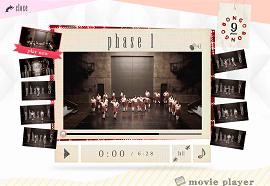■企画主旨


1994年、フォーサイスのフランクフルト・バレエ団の芸術監督就任10周年を祝うために、カールスルーエにあるメディア・テクノロジー・センター(ZKM)と共同制作して作られた『インプロヴィゼーション・テクノロジーズ』は、当時最新のメディア・テクノロジーを駆使してインタラクティヴに独習することができるように、彼の特異なダンス・ヴォキャブラリーを採集・編集して作られた「動きの辞書」のようなものだった。
その後オハイオ州立大学と共に作られたのが『シンクロナス・オブジェクツ』で、彼の代表的な作品One flat thing reproduced(俗称テーブル・ダンス)を分析してデータ化し図像化した、いわば身体的な思考が自由にイラストレーション化される実例が満載されている。HPに無料で自由にアクセスできる。
http://synchronousobjects.osu.edu/
そこで今回、私たちが紹介するBongo Bongoは、彼の作品を実際に踊ってみようというメイキングを主旨とする。上記のように辞書があり、作品分析があるのだから、そろそろ大胆にも彼の作品を踊ってしまえという意図から生まれた。
日本女子体育大学ダンス・プロデュース研究部は、実はすでにこのBongo Bongoを映像を見て、いわばパクって自分たちで振りうつしをして踊ってきているのだが、2011年、東京ドイツ文化センター、慶應義塾アートセンターとの共催による「身体のイラストレーション」というワークショップ&シンポジウムが行われた際に、ではこのメイキングをHPに載せて誰でもが無料でアクセスできるようにしようという案が出て、それが具体化されて、実現にいたったのがこの企画。
このダンス作品はミッションスクール・ガール・ダンスとも言われて、女子制服を来たダンサー(本来は男性も女装する)が動きを繰り返して最後は大団円になって踊る、盆踊りのようでもあるので、みんなで踊るには楽しい。
しかし実は振付自体はむずかしい。踊る側はもっとシンプルに自由にアレンジしていい。フォーサイスもみんなが自由に踊って楽しんでくれるのが一番いいと言っている。
中学の体育授業でダンスが必修になった。このBongo Bongoも利用されると嬉しい。
■Project Outline
“Improvisation Technologies”, co-produced with Media Technology Center (ZKM) in Karlsruhe in 1994 to celebrate the 10th anniversary of Forsythe’s appointment to Frankfurt Ballet, was like a ‘movement dictionary’ created by collecting and editing his unique movements, that made people learn those movements interactively by themselves using the latest media technologies at that time.
After that “Synchronous Objects” was created with the Ohio State University, to analyze, compile, and illustrate movements of his signature work “One Flat Thing Reproduced (popularly known as Table Dance)”. In a way it is full with the examples of freely-illustrated physical thoughts. Anyone can access the website for free. http://synchronousobjects.osu.edu/
This time the BongoBongo we are introducing aims to show the process of our actually trying to dance his work. Because we have such a dictionary and the analysis of his work as above, we dare to dance his work using those tools. That is how it happened.
The Dance Produce Study Group of Japan Women’s College of Physical Education (JWCPE) has been practicing Bongo Bongo by copying the movements in such videos. Then in 2011 when workshop & symposium of ‘Illustration of the Body’ was organized by Goethe Institut in Tokyo and Keio University Arts Center, we had an idea to show our choreography learning process via a website and anybody can access to it for free. From there this project has started and been realized.
This dance piece is also called mission-school-girl’s dance, in which dancers in girl’s school uniforms (originally male dancers also in girl’s uniform) repeat a series of movements and end up dancing in a large circle. It is something like Japanese Bon festival dance (Bon Odori in Japanese), so it would be very enjoyable for people to dance this piece together.
However, the choreography itself is quite challenging. Learning dancers could arrange it more freely and simply. Mr. Forsythe also said it would be the best if everyone could enjoy dancing freely.
Dance education became mandatory in the PE curriculum of junior high schools in Japan.
We will be happy if Bongo Bongo is used for such dance education.



